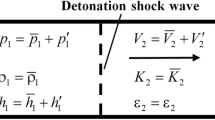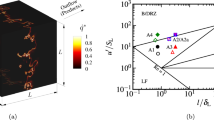Abstract
In shock tube experiments, the interaction between the reflected shock and boundary layer can induce shock bifurcation and weak ignition. The weak ignition can greatly affect the ignition delay time measurement in a shock tube experiment. In this work, two-dimensional simulations considering detailed chemistry and transport are conducted to investigate the shock bifurcation and non-uniform ignition behind a reflected shock. The objectives are to interpret the formation of shock bifurcation induced by the reflected shock and boundary layer interaction and to investigate the weak ignition and its transition to strong ignition for both hydrogen and dimethyl ether. It is found that the non-uniform reflection of the incident shock at the end wall produces a wedge-shaped oblique shock foot at the wall. The wedge-shaped structure results in strong interactions between reflected shock and boundary layer, which induces the shock bifurcation. It is demonstrated that the local high-temperature spots at the foot of the bifurcated shock is caused by viscous dissipation and pressure work. As the post-reflected shock temperature increases, the transition from weak ignition to strong ignition in a stoichiometric hydrogen/oxygen mixture is observed. The relative sensitivity of ignition delay time to the post-reflected shock temperature is introduced to characterize the appearance of weak ignition behind the reflected shock. Unlike in the hydrogen/oxygen mixture, weak ignition is not observed in the stoichiometric dimethylether/oxygen mixture since it has a relatively longer ignition delay time and smaller relative sensitivity.
摘要
在激波管实验中, 反射激波与边界层的相互作用会导致激波分叉和弱点火. 在激波管实验中, 弱点火会严重影响点火延迟时间的测量. 在考虑详细的化学和输运效应下, 本文通过二维数值模拟研究反射激波后的激波分岔和非均匀点火, 以解释反射激波和边界层相互作用引发激波分岔的形成机理, 并研究氢和二甲醚的弱点火及其向强点火的转变. 研究发现入射激波在端壁的非均匀反射会在壁面产生一个楔形斜激波脚. 楔形结构导致反射激波和边界层之间的强烈相互作用, 从而导致激波分岔. 结果表明分叉激波底部的局部高温点产生于黏性耗散和压力功. 随着反射后激波温度的升高, 在化学计量氢/氧混合物中观察到从弱点火到强点火的转变. 通过引入点火延迟时间对反射后激波温度的相对灵敏度, 可以表征反射激波后弱点火出现. 与氢/氧混合物不同, 在二甲醚/氧混合物中未观察到弱点火现象, 因为其具有相对较长的点火延迟时间和较小的相对灵敏度.
Similar content being viewed by others
References
N. A. Fomin, 110 years of experiments on shock tubes, J. Eng. Phys. Thermophy. 83, 1118 (2010).
N. Chaumeix, B. Imbert, L. Catoire, and C. E. Paillard, The onset of detonation behind shock waves of moderate intensity in gas phase, Combust. Sci. Tech. 186, 607 (2014).
R. K. Hanson, and D. F. Davidson, Recent advances in laser absorption and shock tube methods for studies of combustion chemistry, Prog. Energy Combust. Sci. 44, 103 (2014).
G. A. Pang, D. F. Davidson, and R. K. Hanson, Experimental study and modeling of shock tube ignition delay times for hydrogen-oxygen-argon mixtures at low temperatures, Proc. Combust. Institut. 32, 181 (2009).
E. L. Petersen, and R. K. Hanson, Nonideal effects behind reflected shock waves in a high-pressure shock tube, Shock Waves 10, 405 (2001).
K. P. Grogan, and M. Ihme, Weak and strong ignition of hydrogen/oxygen mixtures in shock-tube systems, Proc. Combust. Institut. 35, 2181 (2015).
J. T. Lipkowicz, I. Wlokas, and A. M. Kempf, Analysis of mild ignition in a shock tube using a highly resolved 3D-LES and high-order shock-capturing schemes, Shock Waves 29, 511 (2019).
C. Huang, C. Qi, and Z. Chen, Non-uniform ignition behind a reflected shock and its influence on ignition delay measured in a shock tube, Shock Waves 29, 957 (2019).
H. Yamashita, J. Kasahara, Y. Sugiyama, and A. Matsuo, Visualization study of ignition modes behind bifurcated-reflected shock waves, Combust. Flame 159, 2954 (2012).
Y. Uygun, S. Ishihara, and H. Olivier, A high pressure ignition delay time study of 2-methylfuran and tetrahydrofuran in shock tubes, Combust. Flame 161, 2519 (2014).
T. Javed, J. Badra, M. Jaasim, E. Es-Sebbar, M. F. Labastida, S. H. Chung, H. G. Im, and A. Farooq, Shock tube ignition delay data affected by localized ignition phenomena, Combust. Sci. Tech. 189, 1138 (2016).
E. Ninnemann, B. Koroglu, O. Pryor, S. Barak, L. Nash, Z. Loparo, J. Sosa, K. Ahmed, and S. Vasu, New insights into the shock tube ignition of H2/O2 at low to moderate temperatures using high-speed end-wall imaging, Combust. Flame 187, 11 (2018).
H. Mark, The interaction of a reflected shock wave with the boundary layer in a shock tube, NACA, TM-1418, (1958).
L. Davies, The Interaction of the Reflected Shock with the Boundary Layer in a Shock Tube and Its Influence on the Duration of Hot Flow in the Reflected-shock Tunnel, Part I, Dissertation for Doctoral Degree (1965).
L. Davies, and J. L. Wilson, Influence of reflected shock and boundary-layer interaction on shock-tube flows, Phys. Fluids 12, I–37 (1969).
H. Kleine, V. Lyakhov, L. Gvozdeva, and H. Grönig, Bifurcation of a reflected shock wave in a shock tube, in: K. Takayama, ed. Shock Waves (Springer, Berlin, 1992) p. 261.
K. Matsuo, S. Kawagoe, and K. Kage, The interaction of a reflected shock wave with the boundary layer in a shock tube, Bull. JSME 17, 1039 (1974).
Y. S. Weber, E. S. Oran, J. P. Boris, and J. D. Anderson Jr., The numerical simulation of shock bifurcation near the end wall of a shock tube, Phys. Fluids 7, 2475 (1995).
V. Daru, and C. Tenaud, Evaluation of TVD high resolution schemes for unsteady viscous shocked flows, Comput. Fluids 30, 89 (2000).
V. Daru, and C. Tenaud, Numerical simulation of the viscous shock tube problem by using a high resolution monotonicity-preserving scheme, Comput. Fluids 38, 664 (2009).
K. P. Grogan, and M. Ihme, Regimes describing shock boundary layer interaction and ignition in shock tubes, Proc. Combust. Institut. 36, 2927 (2017).
S. Chen, Q. Sun, I. Klioutchnikov, and H. Olivier, Numerical study of chemically reacting flow in a shock tube using a high-order point-implicit scheme, Comput. Fluids 184, 107 (2019).
E. L. Petersen, and R. K. Hanson, Measurement of reflected-shock bifurcation over a wide range of gas composition and pressure, Shock Waves 15, 333 (2006).
R. A. Strehlow, and A. Cohen, Limitations of the reflected shock technique for studying fast chemical reactions and its application to the observation of relaxation in nitrogen and oxygen, J. Chem. Phys. 30, 257 (1959).
V. V. Voevodsky, and R. I. Soloukhin, On the mechanism and explosion limits of hydrogen-oxygen chain self-ignition in shock waves, Sym. (Int.) Combust. 10, 279 (1965).
J. W. Meyer, and A. K. Oppenheim, On the shock-induced ignition of explosive gases, Sym. (Int.) Combust. 13, 1153 (1971).
M. Asahara, Y. Shirakawa, A. Hayashi, and N. Tsuboi, Strong and mild ignition mechanism behind reflected shock waves in hydrogen mixture, in: 4th International Seminar on Fire and Explosion Hazards (2013).
R. Deiterding, Parallel Adaptive Simulation of Multi-dimensional Detonation Structures, Dissertation for Doctoral Degree (Brandenburg University of Technology, Senftenberg, 2003).
R. Deiterding, A parallel adaptive method for simulating shock-induced combustion with detailed chemical kinetics in complex domains, Comput. Struct. 87, 769 (2009).
R. Deiterding, Block-structured adaptive mesh refinement-theory, implementation and application, ESAIM-Proc. 34, 97 (2011).
R. Deiterding, High-resolution numerical simulation and analysis of Mach reflection structures in detonation waves in low-pressure H2-O2-Ar mixtures: A summary of results obtained with the adaptive mesh refinement framework AMROC, J. Combust. 2011, 1 (2011).
J. L. Ziegler, Simulations of Compressible, Diffusive, Reactive Flows with Detailed Chemistry using a High-order Hybrid WENO-CD Scheme, Dissertation for Doctoral Degree (California Institute of Technology, Pasadena, 2012).
Y. Wang, C. Huang, R. Deiterding, H. Chen, and Z. Chen, Propagation of gaseous detonation across inert layers, Proc. Combust. Institut. 38, 3555 (2021).
Y. Wang, Z. Chen, and H. Chen, Diffraction of weakly unstable detonation through an obstacle with different sizes and shapes, Phys. Rev. Fluids 6, 043201 (2021).
J. Li, Z. Zhao, A. Kazakov, and F. L. Dryer, An updated comprehensive kinetic model of hydrogen combustion, Int. J. Chem. Kinet. 36, 566 (2004).
A. Bhagatwala, Z. Luo, H. Shen, J. A. Sutton, T. Lu, and J. H. Chen, Numerical and experimental investigation of turbulent DME jet flames, Proc. Combust. Institut. 35, 1157 (2015).
C. Huang, Numerical Studies on Shock-induced Ignition and Detonation Development, Dissertation for Doctoral Degree (Peking University, Beijing, 2020).
J. Damazo, J. Ziegler, J. Karnesky, and J. E. Shepherd, Investigating shock wave-boundary layer interaction caused by reacting detonations, in: 8th International Symposium on Hazards, Prevention and Mitigation of Industrial Explosions (Yokohama, 2010).
A. Deshpande, and B. Puranik, Effect of viscosity and wall heat conduction on shock attenuation in narrow channels, Shock Waves 26, 465 (2016).
G. Wilson, S. Sharma, and W. Gillespie, Time-dependent simulation of reflected-shock/boundary layer interaction, in: 31st Aerospace Sciences Meeting (Reno, 1993).
A. Knisely, J. M. Austin, C. Bacon, and A. Khokhlov, Strong and weak ignition in 2H2 + O2 behind reflected shocks in two-dimensional Navier-Stokes simulations with detailed chemistry, in: 29th International Symposium on Shock Waves (Springer, Berlin, 2013).
J. H. Lee, R. Knystautas, and N. Yoshikawa, Photochemical initiation of gaseous detonations, Acta Astronaut. 5, 971 (1978).
R. Blumenthal, K. Fieweger, K. H. Komp, and G. Adomeit, Gas dynamic features of self ignition of non diluted fuel/air mixtures at high pressure, Combust. Sci. Tech. 123, 1 (1997).
Author information
Authors and Affiliations
Corresponding author
Additional information
This work was supported by the National Natural Science Foundation of China (Grant Nos. 52006001, and 52176096). We thank Prof. Shengkai Wang at Peking University, Dr. Song Chen at Technische Universität München and Dr. Wang Han at University of Edinburgh for helpful discussion.
Rights and permissions
About this article
Cite this article
Huang, C., Wang, Y., Deiterding, R. et al. Numerical studies on weak and strong ignition induced by reflected shock and boundary layer interaction. Acta Mech. Sin. 38, 121466 (2022). https://doi.org/10.1007/s10409-021-09011-x
Received:
Accepted:
Published:
DOI: https://doi.org/10.1007/s10409-021-09011-x




